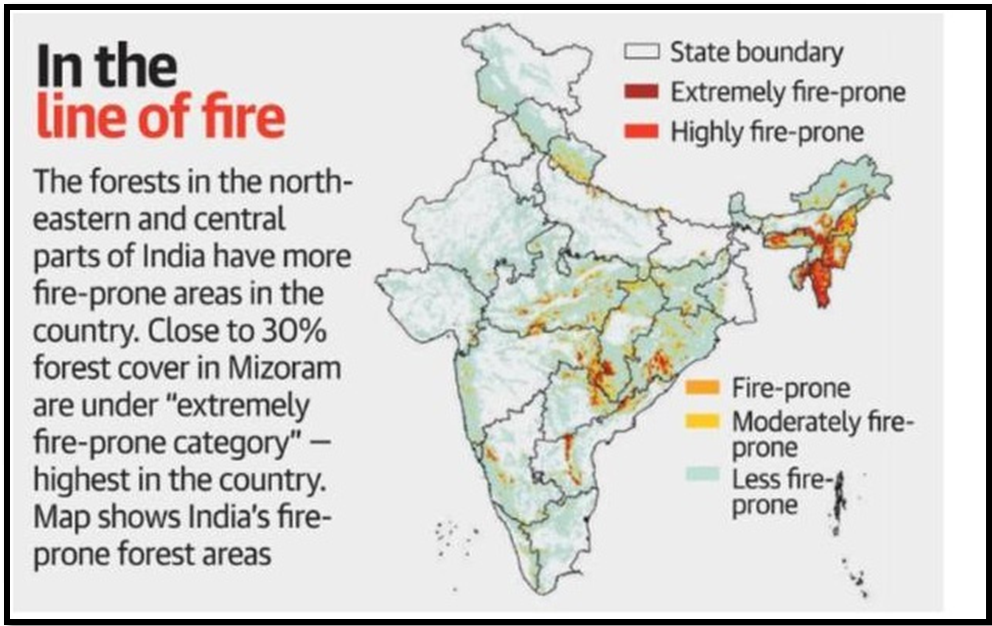FOREST FIRES IN HIMACHAL PRADESH: CAUSES, IMPACTS, AND MITIGATION STRATEGIES
Syllabus:
- GS-3- Forest Fire in India , implications , Climate change induced fires , Solutions
Focus :
- The article discusses the increasing frequency of forest fires in Himachal Pradesh, examining their causes, impacts on the environment and wildlife, historical transformations of the Himalayan forests, and proposes necessary actions for sustainable forest management and community involvement.
Source - TH
Introduction
- Widespread Forest Fires: Himachal Pradesh (H.P.) is experiencing numerous forest fires, with 1,684 incidents reported since April 15, damaging 17,471 hectares of forest land.
- Loss of Tree Cover: From 2001 to 2023, H.P. lost 957 hectares of tree cover due to fires and an additional 4.37 thousand hectares from other causes.
Causes of Forest Fires
- Natural Factors: Fires often occur during the pre-monsoon summer period due to moisture stress and depletion of snowmelt water.
- Human Activities: Common human-induced causes include unattended campfires and discarded cigarettes.
- Faulty Forestry Practices: Utilitarian approaches to forestry, excluding community participation, contribute to the problem.
Environmental Impact
- Pollutants: Forest fires release pollutants, including black carbon, which accelerates glacier melt in the Himalayas and affects the regional climate.
- Wildlife Damage: Fires cause significant loss to wildlife habitats and biodiversity.
Historical Transformation of Himalayan Forests
- Railway Construction: The construction of railways in the 1850s marked a significant transformation in Indian forestry, leading to extensive deforestation.
- Commercial Exploitation: From 1853 to 1910, around 80,000 km of railway tracks were laid, resulting in the large-scale extraction of Deodar and Chir pine trees for timber and resin.
- Banj Oak Replacement: State-managed forestry led to the replacement of Banj oak, which retains moisture better, with commercially valuable Chir pine.
- Ecological Importance of Banj Oak: Highlight the ecological benefits of Banj oak forests in water retention and spring rejuvenation.
- Current Forest Composition–Chir Pine Dominance: Currently, 17.8% of H.P.’s 37,033 square kilometers of forest area is covered with Chir pine, which is highly susceptible to fires.
Need for Democratisation of Forests
- Community Involvement: Democratising forest management is essential to include local communities who have lived in and around forests.
- Traditional Rights: Historically, Himalayan dwellers had rights to extract wood, timber, and fodder. These rights have been curtailed, affecting community involvement in firefighting.
Legal and Constitutional Framework
- Schedule V of the Indian Constitution:P. is under Schedule V, requiring community consent for development activities. However, large projects often bypass this requirement, leading to forest diversion.
Proposed Solutions
- Mixed Forestry: Develop mixed forests by removing fire-prone pine trees and promoting diverse species.
- Scientific and Community Knowledge: Integrate scientific research with local community knowledge for effective forest management.
- Water Conservation: Implement check dams and other methods to revive water springs.
- Environmental Services: Establish environmental services at the village level to involve local communities in conservation efforts.
- Policy Advocacy: Advocate for support from the 16th Finance Commission, focusing on disaster mitigation funds and sustainable forest management.
- Challenges in Policy Implementation: Address the challenges in implementing policies that balance development needs and environmental conservation.
- Role of Technology: Explore the role of modern technology in monitoring and managing forest fires.
- Case Studies: Include case studies of successful community-managed forests to illustrate best practices.
- Climate Change Impact: Discuss how climate change exacerbates the frequency and intensity of forest fires.
- Economic Consequences: Evaluate the economic impact of forest fires on local communities and the state’s economy.
- International Cooperation: Suggest the need for international cooperation in sharing best practices and technologies for forest fire management.
Importance of Community Engagement
- First Responders: Ensuring local communities are trained and equipped to act as first responders during forest fires.
- Awareness Campaigns: Conduct awareness campaigns to educate the public on preventing forest fires and the importance of forest conservation.
- Traditional Knowledge: Leverage traditional knowledge and practices in forest management and fire prevention.
- Sustainable Livelihoods: Promote sustainable livelihoods that depend on healthy forests, reducing the incentive for activities that lead to forest fires.
Conclusion
- Comprehensive Approach: A multifaceted approach involving scientific research, community participation, legal reforms, and sustainable practices is crucial to manage forest fires and preserve Himachal Pradesh’s forests.
- Sustainable Future: Emphasize the importance of a sustainable future for Himachal Pradesh’s forests through integrated efforts involving policy, community, and environmental stewardship.
Source:The Hindu
Associated Article :
https://universalinstitutions.com/forest-fire-in-jammus-gangera-hills-raises-alarms-amid-heatwave/
Mains Practice Question :
GS-3
“Analyze the causes and impacts of forest fires in Himachal Pradesh. Discuss the historical changes in forestry practices and suggest comprehensive measures for sustainable forest management and community involvement.”(250 words)




